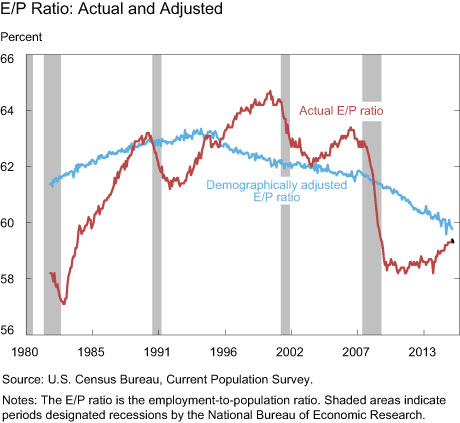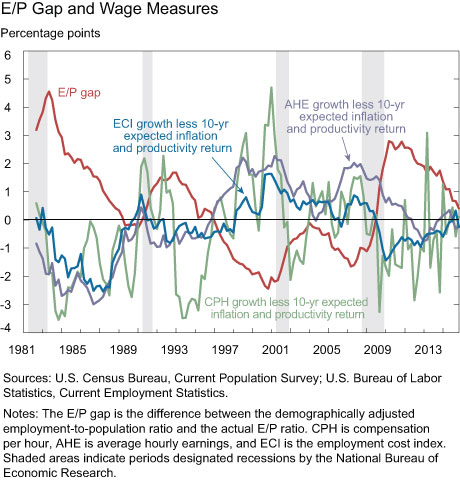Indicators of labor market slack enable economists to judge pressures on wages and prices. Direct measures of slack, however, are not available and must be constructed. Here, we build on our previous work using the employment-to-population (E/P) ratio and develop an updated measure of labor market slack based on the behavior of labor compensation. Our measure indicates that roughly 90 percent of the labor gap that opened up following the recession has been closed.
An earlier post, “A Mis-Leading Labor Market Indicator,” argued that the gap between the E/P ratio and a demographically adjusted version of the same ratio is a useful measure of labor market slack. A challenge in constructing this measure is that it requires a normalization (a level shift) to “re-center” the demographically adjusted E/P ratio. In this earlier post, we normalized by assuming that the average labor gap should be zero over a long period of time. Although this approach was easy to implement, it had the disadvantage of not being linked to wage behavior.
To better motivate an E/P-based approach, we turn to Phillips curve models that relate wage growth to labor market slack. The specification we consider relates nominal wage growth to an E/P gap variable (defined as the difference between a demographically adjusted E/P ratio and the actual E/P ratio), as well as expected inflation and trend productivity growth. Expected inflation is subtracted from nominal wage growth to derive an expected real wage growth series, which is then regressed on a constant, the E/P gap, and trend productivity growth. The E/P gap is normalized so that the estimated intercept of the Phillips curve model is set to zero. This approach implies that when the resulting normalized E/P gap is zero, expected real wage growth adjusted for the return to labor productivity is, on average, zero. That is, a labor market with no slack will have nominal wage growth, on average, equal to expected inflation plus a return to labor productivity.
We estimate Phillips curve models for three wage measures: compensation per hour, average hourly earnings, and the employment cost index. We construct four-quarter-ahead growth rates starting in the first quarter of 1982, the earliest start date for which all three measures are available, and ending in the second quarter of 2015. Expected inflation is measured using survey data on ten-year CPI inflation expectations, and trend productivity growth is a twelve-quarter moving average of (annualized) productivity growth rates. Adopting the same approach we took in another post—“U.S. Potential Economic Growth: Is it Improving with Age?”—we have extended the data sample used to estimate the demographically adjusted E/P ratio back to the early 1960s. This provides us with roughly thirteen million observations on individuals that we divide into 280 cohorts based on decade of birth, sex, race/ethnicity, and educational attainment. For each cohort, we estimate a cohort-specific profile for average employment rates by age that abstracts from cyclical effects. Aggregating these predicted employment rates across individuals produces a demographically adjusted E/P ratio, with the quarterly series derived as an average of the three monthly values.
The three Phillips curve models yield similar normalizations, so we average them instead of selecting one. The chart below shows the actual E/P ratio along with the demographically adjusted E/P ratio based on this new normalization.

The next chart plots the estimated E/P gap (the difference between the two series in the chart above) along with the three expected real wage growth measures adjusted for trend productivity growth. By our definition, a positive E/P gap indicates slack in the labor market. The periods in which the estimated E/P gap is zero line up well with the periods in which our adjusted real wage growth measures are also close to zero. Moreover, periods in which the adjusted wage measures have exceeded zero generally correspond to episodes of tight labor markets (negative E/P gaps), while periods in which the measures are below zero are typically associated with slack in the labor market (positive E/P gaps).

The current normalized E/P gap is estimated to be 32 basis points, which represents an 89 percent reduction from the 283-basis-point gap in November 2010. This finding suggests that the labor market has made considerable progress in its recovery, but is still not yet back to neutral. To gain additional perspective on this finding, we can compare the current gap with those that existed in two earlier tightening episodes. At the time the FOMC began to raise rates in February 1994, the gap was 92 basis points; at the end of that tightening cycle, it was 14 basis points. And when the Committee began to raise rates in June 2004, the gap was -38 basis points; at the end of that tightening cycle, the gap was -125 basis points. To assess labor market slack and understand the behavior of labor compensation in the quarters ahead, it will be particularly important to mind the gap.
Disclaimer
The views expressed in this post are those of the authors and do not necessarily reflect the position of the Federal Reserve Bank of New York or the Federal Reserve System. Any errors or omissions are the responsibility of the authors.

Joseph Tracy is an executive vice president and senior advisor to the president of the Federal Reserve Bank of New York.

Robert Rich is an assistant vice president in the Bank’s Research and Statistics Group.
Samuel Kapon is a former senior research analyst in the Research and Statistics Group.

Ellen Fu is a senior research analyst in the Research and Statistics Group.











 RSS Feed
RSS Feed Follow Liberty Street Economics
Follow Liberty Street Economics
The demographically adjusted E/P ratio declines only slightly during the Great Recession. This seems like a problem. Did lots of people suddenly get older right as the recession arrived? It seems instead that this is an econometric artifact.
Quite interesting. Could you provide a link to the calculation of the demographically adjusted E/P series? Thank you.